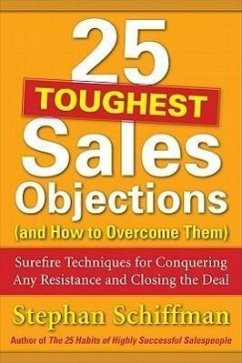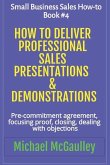Stephan Schiffman
25 Toughest Sales Objections-and How to Overcome Them
Schade – dieser Artikel ist leider ausverkauft. Sobald wir wissen, ob und wann der Artikel wieder verfügbar ist, informieren wir Sie an dieser Stelle.
Stephan Schiffman
25 Toughest Sales Objections-and How to Overcome Them
- Broschiertes Buch
- Merkliste
- Auf die Merkliste
- Bewerten Bewerten
- Teilen
- Produkt teilen
- Produkterinnerung
- Produkterinnerung
Turn common objections into BIG OPPORTUNITIES! It costs too much... We're switching to overseas vendors... Let me think about it... NO! You can do one of two things when a customer is reluctant to buy: You can back off or go in for the kill. 25 Toughest Sales Objections--and How to Overcome Them helps you choose which direction is the best approach and gives you the tools you need to defl ect that obstacle and make the sale. Bestselling author and renowned sales guru Stephan Schiffman has tapped into his decades of hands-on experience training sales professionals and has boiled his list of…mehr
Andere Kunden interessierten sich auch für
![The 25 Most Common Sales Mistakes and How to Avoid Them The 25 Most Common Sales Mistakes and How to Avoid Them]() Stephan SchiffmanThe 25 Most Common Sales Mistakes and How to Avoid Them11,99 €
Stephan SchiffmanThe 25 Most Common Sales Mistakes and How to Avoid Them11,99 €![Red Hot Customer Experience: Challenges Your Business Will Face in the Next Normal (And How to Overcome Them!)) Red Hot Customer Experience: Challenges Your Business Will Face in the Next Normal (And How to Overcome Them!))]() Lisbeth CalandrinoRed Hot Customer Experience: Challenges Your Business Will Face in the Next Normal (And How to Overcome Them!))27,99 €
Lisbeth CalandrinoRed Hot Customer Experience: Challenges Your Business Will Face in the Next Normal (And How to Overcome Them!))27,99 €![How to Deliver Professional Sales Presentations & Demonstrations: Pre-commitment agreement, Focusing proof, closing, dealing with objections How to Deliver Professional Sales Presentations & Demonstrations: Pre-commitment agreement, Focusing proof, closing, dealing with objections]() Michael McGaulleyHow to Deliver Professional Sales Presentations & Demonstrations: Pre-commitment agreement, Focusing proof, closing, dealing with objections12,99 €
Michael McGaulleyHow to Deliver Professional Sales Presentations & Demonstrations: Pre-commitment agreement, Focusing proof, closing, dealing with objections12,99 €![Effective Practical Strategies to Overcome Customers' Objections: in the New Era of Auto Sales Effective Practical Strategies to Overcome Customers' Objections: in the New Era of Auto Sales]() Okonko Basil Nwachukwu Ph. D.Effective Practical Strategies to Overcome Customers' Objections: in the New Era of Auto Sales18,99 €
Okonko Basil Nwachukwu Ph. D.Effective Practical Strategies to Overcome Customers' Objections: in the New Era of Auto Sales18,99 €![The 25 Sales Habits of Highly Successful Salespeople The 25 Sales Habits of Highly Successful Salespeople]() Stephan SchiffmanThe 25 Sales Habits of Highly Successful Salespeople7,99 €
Stephan SchiffmanThe 25 Sales Habits of Highly Successful Salespeople7,99 €
Turn common objections into BIG OPPORTUNITIES! It costs too much... We're switching to overseas vendors... Let me think about it... NO! You can do one of two things when a customer is reluctant to buy: You can back off or go in for the kill. 25 Toughest Sales Objections--and How to Overcome Them helps you choose which direction is the best approach and gives you the tools you need to defl ect that obstacle and make the sale. Bestselling author and renowned sales guru Stephan Schiffman has tapped into his decades of hands-on experience training sales professionals and has boiled his list of objections down to the top 25 most frustrating, universal issues. Through sample dialogues and occasionally humorous examples any salesperson can relate to, Schiffman provides the solutions to help turn any "No" into a done deal. At long last, the sales objection has met its match. Stephan Schiffman provides you with an arsenal that helps you combat any negative response and, in the process, turns perceptions of you from sales rep to ultimate problem solver.
Produktdetails
- Produktdetails
- Verlag: McGraw-Hill Education
- Seitenzahl: 258
- Erscheinungstermin: 13. Juni 2011
- Englisch
- Abmessung: 229mm x 152mm x 14mm
- Gewicht: 379g
- ISBN-13: 9780071767378
- ISBN-10: 0071767371
- Artikelnr.: 32730321
- Herstellerkennzeichnung
- Libri GmbH
- Europaallee 1
- 36244 Bad Hersfeld
- gpsr@libri.de
- Verlag: McGraw-Hill Education
- Seitenzahl: 258
- Erscheinungstermin: 13. Juni 2011
- Englisch
- Abmessung: 229mm x 152mm x 14mm
- Gewicht: 379g
- ISBN-13: 9780071767378
- ISBN-10: 0071767371
- Artikelnr.: 32730321
- Herstellerkennzeichnung
- Libri GmbH
- Europaallee 1
- 36244 Bad Hersfeld
- gpsr@libri.de
Stephan Schiffman (New York, NY) has been cited as America's #1 Corporate Sales Trainer. He is the author of numerous best-selling books including Cold Calling Techniques That Really Work (now in its 4th edition).
Chapter 1. It costs too much:How to overcome the problem of pricing;
Chapter 2. It's not good enough: You need to meet the challenge of quality
head on and figure out what the customer is really objecting to. Most of
the time, it's not quality, it's function;chapter 3. I'm worried about it:
What's the customer worried about? That it won't solve his problem?;
chapter 4. If I buy it, I'll lose my job: The customer is concerned about
his place in the company pecking order. How to reassure him;Chapter 5. I
really hate the rep: You? Or the previous rep? How to overcome the
reputation of your company;Chapter 6. This isn't the kind of thing our
customers need: So whatdo your customers need. Figuring out your client's
real problem;Chapter 7. I don't need the service or product: Yes, you do.
You just don't know it. How to understand what the customer's really
saying;Chapter 8. You have not offered me one real reason to buy: What does
the customer want you to say?; Chapter 9. Your company has a bad track
record: Yes, but how are you different? If your company's messed up in the
past, how to rebuild trust;Chapter 10. We don't need some of the product's
features:You do, but you don't know it. The difference between what your
customer thinks he wants and what he really wants;Chapter 11. We're
switching to overseas vendors: The value of staying with what you know.
Overseas vendors are a difficult challenge; Chapter 12. Your service
doesn't fit in with our company's culture: Well, what is your company's
culture? And why is that culture beneficial to the company's overall
goals?;Chapter 13. Give me a better price:Price is a negotiating point. We
can always find a better price, but it's going to be at the expense of
something else;Chaptert 14. I can not get delivery when I need it: Delivery
dates are flexible. But what's the customer willing to give up to get the
delivery date he needs?;Chapter 15. The product is a commodity and I can
get it elsewhere: What's unique about your product? What can you supply
that the customer can't get elsewhere;Chapter 16. Let me think about it:
Sure, but the offer isn't stagnant. Make your customer understand that
you've got other clients anxious for your services;Chapter 17. You haven't
been honest with me: Trust is essential in a business relationship. What
you've got to be open about;Chapter 18. I'm getting out of the business
that your product is aimed at:If your client is thinking about getting into
another business, that's a whole new set of opportunities;Chapter 19.
Price is no object: If the client doesn't have a problem with price,
there's going to be a trade off with something else. How to figure out what
it is;Chapter 20. I make the decisions, there is no one else to see: But
there's always someone else to see. How to get past the guardians of the
upper echelons;Chapter 21. The board of directors will have the final say:
Sure, they will. But what can you decide on? How to make sales at lower
levels of the organization;chapter 22. You have to meet with the board
which is impossible: The board never wants to make decisions. They delegate
that power to someone else. How to find out who that "someone else" is;
Chapter 23. We are happy with our current vendor: No, you're not. Otherwise
we wouldn't be talking. Somewhere, somehow, your current vendor isn't doing
everything you want; Chapter 24. We bought from your company in the past:
Companies always like to find fresh vendors, but there's a comfort factor
in staying with the tried and true;Chapter 25. Everything you say is true:
How to overcome the non-decision decision. Everyone likes closure; take
advantage of this;Chapter 26. We don't need any at this time: This is an
opening. Even if the company doesn't need what you're selling at the
moment, clinch future sales;Chapter 27. I am an idiot: How to deal with an
incompetent manager/buyer. Sometimes they're the best people to sell to;
Chapter 28. NO: When is an object truly an objection and how you can change
that into a sales opportunity.
Chapter 2. It's not good enough: You need to meet the challenge of quality
head on and figure out what the customer is really objecting to. Most of
the time, it's not quality, it's function;chapter 3. I'm worried about it:
What's the customer worried about? That it won't solve his problem?;
chapter 4. If I buy it, I'll lose my job: The customer is concerned about
his place in the company pecking order. How to reassure him;Chapter 5. I
really hate the rep: You? Or the previous rep? How to overcome the
reputation of your company;Chapter 6. This isn't the kind of thing our
customers need: So whatdo your customers need. Figuring out your client's
real problem;Chapter 7. I don't need the service or product: Yes, you do.
You just don't know it. How to understand what the customer's really
saying;Chapter 8. You have not offered me one real reason to buy: What does
the customer want you to say?; Chapter 9. Your company has a bad track
record: Yes, but how are you different? If your company's messed up in the
past, how to rebuild trust;Chapter 10. We don't need some of the product's
features:You do, but you don't know it. The difference between what your
customer thinks he wants and what he really wants;Chapter 11. We're
switching to overseas vendors: The value of staying with what you know.
Overseas vendors are a difficult challenge; Chapter 12. Your service
doesn't fit in with our company's culture: Well, what is your company's
culture? And why is that culture beneficial to the company's overall
goals?;Chapter 13. Give me a better price:Price is a negotiating point. We
can always find a better price, but it's going to be at the expense of
something else;Chaptert 14. I can not get delivery when I need it: Delivery
dates are flexible. But what's the customer willing to give up to get the
delivery date he needs?;Chapter 15. The product is a commodity and I can
get it elsewhere: What's unique about your product? What can you supply
that the customer can't get elsewhere;Chapter 16. Let me think about it:
Sure, but the offer isn't stagnant. Make your customer understand that
you've got other clients anxious for your services;Chapter 17. You haven't
been honest with me: Trust is essential in a business relationship. What
you've got to be open about;Chapter 18. I'm getting out of the business
that your product is aimed at:If your client is thinking about getting into
another business, that's a whole new set of opportunities;Chapter 19.
Price is no object: If the client doesn't have a problem with price,
there's going to be a trade off with something else. How to figure out what
it is;Chapter 20. I make the decisions, there is no one else to see: But
there's always someone else to see. How to get past the guardians of the
upper echelons;Chapter 21. The board of directors will have the final say:
Sure, they will. But what can you decide on? How to make sales at lower
levels of the organization;chapter 22. You have to meet with the board
which is impossible: The board never wants to make decisions. They delegate
that power to someone else. How to find out who that "someone else" is;
Chapter 23. We are happy with our current vendor: No, you're not. Otherwise
we wouldn't be talking. Somewhere, somehow, your current vendor isn't doing
everything you want; Chapter 24. We bought from your company in the past:
Companies always like to find fresh vendors, but there's a comfort factor
in staying with the tried and true;Chapter 25. Everything you say is true:
How to overcome the non-decision decision. Everyone likes closure; take
advantage of this;Chapter 26. We don't need any at this time: This is an
opening. Even if the company doesn't need what you're selling at the
moment, clinch future sales;Chapter 27. I am an idiot: How to deal with an
incompetent manager/buyer. Sometimes they're the best people to sell to;
Chapter 28. NO: When is an object truly an objection and how you can change
that into a sales opportunity.
Chapter 1. It costs too much:How to overcome the problem of pricing;
Chapter 2. It's not good enough: You need to meet the challenge of quality
head on and figure out what the customer is really objecting to. Most of
the time, it's not quality, it's function;chapter 3. I'm worried about it:
What's the customer worried about? That it won't solve his problem?;
chapter 4. If I buy it, I'll lose my job: The customer is concerned about
his place in the company pecking order. How to reassure him;Chapter 5. I
really hate the rep: You? Or the previous rep? How to overcome the
reputation of your company;Chapter 6. This isn't the kind of thing our
customers need: So whatdo your customers need. Figuring out your client's
real problem;Chapter 7. I don't need the service or product: Yes, you do.
You just don't know it. How to understand what the customer's really
saying;Chapter 8. You have not offered me one real reason to buy: What does
the customer want you to say?; Chapter 9. Your company has a bad track
record: Yes, but how are you different? If your company's messed up in the
past, how to rebuild trust;Chapter 10. We don't need some of the product's
features:You do, but you don't know it. The difference between what your
customer thinks he wants and what he really wants;Chapter 11. We're
switching to overseas vendors: The value of staying with what you know.
Overseas vendors are a difficult challenge; Chapter 12. Your service
doesn't fit in with our company's culture: Well, what is your company's
culture? And why is that culture beneficial to the company's overall
goals?;Chapter 13. Give me a better price:Price is a negotiating point. We
can always find a better price, but it's going to be at the expense of
something else;Chaptert 14. I can not get delivery when I need it: Delivery
dates are flexible. But what's the customer willing to give up to get the
delivery date he needs?;Chapter 15. The product is a commodity and I can
get it elsewhere: What's unique about your product? What can you supply
that the customer can't get elsewhere;Chapter 16. Let me think about it:
Sure, but the offer isn't stagnant. Make your customer understand that
you've got other clients anxious for your services;Chapter 17. You haven't
been honest with me: Trust is essential in a business relationship. What
you've got to be open about;Chapter 18. I'm getting out of the business
that your product is aimed at:If your client is thinking about getting into
another business, that's a whole new set of opportunities;Chapter 19.
Price is no object: If the client doesn't have a problem with price,
there's going to be a trade off with something else. How to figure out what
it is;Chapter 20. I make the decisions, there is no one else to see: But
there's always someone else to see. How to get past the guardians of the
upper echelons;Chapter 21. The board of directors will have the final say:
Sure, they will. But what can you decide on? How to make sales at lower
levels of the organization;chapter 22. You have to meet with the board
which is impossible: The board never wants to make decisions. They delegate
that power to someone else. How to find out who that "someone else" is;
Chapter 23. We are happy with our current vendor: No, you're not. Otherwise
we wouldn't be talking. Somewhere, somehow, your current vendor isn't doing
everything you want; Chapter 24. We bought from your company in the past:
Companies always like to find fresh vendors, but there's a comfort factor
in staying with the tried and true;Chapter 25. Everything you say is true:
How to overcome the non-decision decision. Everyone likes closure; take
advantage of this;Chapter 26. We don't need any at this time: This is an
opening. Even if the company doesn't need what you're selling at the
moment, clinch future sales;Chapter 27. I am an idiot: How to deal with an
incompetent manager/buyer. Sometimes they're the best people to sell to;
Chapter 28. NO: When is an object truly an objection and how you can change
that into a sales opportunity.
Chapter 2. It's not good enough: You need to meet the challenge of quality
head on and figure out what the customer is really objecting to. Most of
the time, it's not quality, it's function;chapter 3. I'm worried about it:
What's the customer worried about? That it won't solve his problem?;
chapter 4. If I buy it, I'll lose my job: The customer is concerned about
his place in the company pecking order. How to reassure him;Chapter 5. I
really hate the rep: You? Or the previous rep? How to overcome the
reputation of your company;Chapter 6. This isn't the kind of thing our
customers need: So whatdo your customers need. Figuring out your client's
real problem;Chapter 7. I don't need the service or product: Yes, you do.
You just don't know it. How to understand what the customer's really
saying;Chapter 8. You have not offered me one real reason to buy: What does
the customer want you to say?; Chapter 9. Your company has a bad track
record: Yes, but how are you different? If your company's messed up in the
past, how to rebuild trust;Chapter 10. We don't need some of the product's
features:You do, but you don't know it. The difference between what your
customer thinks he wants and what he really wants;Chapter 11. We're
switching to overseas vendors: The value of staying with what you know.
Overseas vendors are a difficult challenge; Chapter 12. Your service
doesn't fit in with our company's culture: Well, what is your company's
culture? And why is that culture beneficial to the company's overall
goals?;Chapter 13. Give me a better price:Price is a negotiating point. We
can always find a better price, but it's going to be at the expense of
something else;Chaptert 14. I can not get delivery when I need it: Delivery
dates are flexible. But what's the customer willing to give up to get the
delivery date he needs?;Chapter 15. The product is a commodity and I can
get it elsewhere: What's unique about your product? What can you supply
that the customer can't get elsewhere;Chapter 16. Let me think about it:
Sure, but the offer isn't stagnant. Make your customer understand that
you've got other clients anxious for your services;Chapter 17. You haven't
been honest with me: Trust is essential in a business relationship. What
you've got to be open about;Chapter 18. I'm getting out of the business
that your product is aimed at:If your client is thinking about getting into
another business, that's a whole new set of opportunities;Chapter 19.
Price is no object: If the client doesn't have a problem with price,
there's going to be a trade off with something else. How to figure out what
it is;Chapter 20. I make the decisions, there is no one else to see: But
there's always someone else to see. How to get past the guardians of the
upper echelons;Chapter 21. The board of directors will have the final say:
Sure, they will. But what can you decide on? How to make sales at lower
levels of the organization;chapter 22. You have to meet with the board
which is impossible: The board never wants to make decisions. They delegate
that power to someone else. How to find out who that "someone else" is;
Chapter 23. We are happy with our current vendor: No, you're not. Otherwise
we wouldn't be talking. Somewhere, somehow, your current vendor isn't doing
everything you want; Chapter 24. We bought from your company in the past:
Companies always like to find fresh vendors, but there's a comfort factor
in staying with the tried and true;Chapter 25. Everything you say is true:
How to overcome the non-decision decision. Everyone likes closure; take
advantage of this;Chapter 26. We don't need any at this time: This is an
opening. Even if the company doesn't need what you're selling at the
moment, clinch future sales;Chapter 27. I am an idiot: How to deal with an
incompetent manager/buyer. Sometimes they're the best people to sell to;
Chapter 28. NO: When is an object truly an objection and how you can change
that into a sales opportunity.






